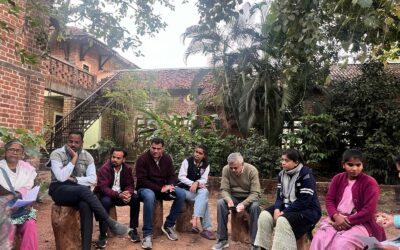Utilizing institutional services and skilled care during childbirth has been proven to improve maternal and perinatal health and to reduce maternal and neonatal mortality rates. In fact, WHO’s key strategy to reduce these mortality rates is to ensure that all births take place in health facilities in which obstetric complications can be treated when they arise. NFHS (National Family Health Survey) data shows that institutional delivery care in India has increased from 43% in 2004 to 83% in 2014. However the percentages remain low for rural areas in most states.
The situation is no different in tribal areas where Swasthya Swaraj works. Physical distance, difficult terrain, unavailability of hospital facilities, and financial constraints are all factors that make it difficult for tribal people in Kalahandi, Odisha to access and avail institutional delivery. Though achieving 100% institutional delivery may not be practically possible, we at Swasthya Swaraj try to ensure that every mother receives skilled care.
One of the strategies we have identified is to leverage the experience and traditional knowledge of generations of Traditional Birth Attendants (TBAs). Over the years, we have been able to identify TBAs in each of the villages where we are working. These are women who have, for years, been midwives. We offer them professional medical training on identifying danger signs as well as conducting safe and hygienic deliveries. We collaborate with TBAs to understand their methods and offer assistance to help them do what they do, a bit better.
Meet Gurubari Parabhoi from Butriguda village in Thumul Rampur block of Kalahandi district. She is one of our rock stars who has assisted mothers in 50+ deliveries. Here, in the pictures below, she demonstrates how she assists the pregnant mother during a home delivery.




Gurubari didi then engages with the mother to help her push the baby out. She carefully massages the mother’s stomach and helps her calm down.
She is proud of how carefully she pulls out the baby. Once the baby is taken out, she wraps the baby in a clean cotton cloth and places the baby on mother’s chest . She then proceeds to take the placenta out, which may take few minutes to an hour!



Once the placenta is removed, Gurubari didi then moves on to cut the umbilical cord. Here, she demonstrates a complicated method called ‘Cord Clamping‘ with ease!
Next, she cleans the baby’s eyes, nose, ears for anything which may have got stuck. After carefully cleaning the baby, she wraps the baby in clean cloth.


Now that the active part of childbirth is over, Didi takes the help of a Swasthya Saathi (para-health worker) and a staff member to record the birth weight and height of the infant. She looks over the mother and child one more time to ensure she hasn’t missed any danger signs. Gurubari didi tells me that her role does not end here. She visits the new mother frequently in the first few weeks to give advice on newborn care. There have been instances when she has also referred the mother and child to our clinic when any complications came up later during one of her visits.
From my conversations with TBAs in our villages, I understand that the role of TBAs like Gurubari didi should not be overlooked. They are accepted by the community, and are held with great respect and honour within their communities. Swasthya Swaraj has worked with TBAs to make inroads into the communities and thereby, improve health and nutritional outcomes of mothers and newborns. Integrating TBAs into our healthcare system and providing them the professional training and support required, has been highly rewarding in the past 7 years.
Perhaps, a similar model can be scaled up at the national level to address the human resource gaps in health sector and to reduce the maternal and infant mortality rates. Training of the TBAs, setting up a prompt referral system to the nearest health centre and integrating them to the formal healthcare system would be beneficial, especially in remote and inaccessible areas.










Beautifully explained!!
Beautifully explained!!
Wonderful 😊
Wonderful 😊
Good conveyance 👌
Good conveyance 👌
Wonderfully explained! Thanks a lot for writing this!
Wonderfully explained! Thanks a lot for writing this!